Back to Don's Maps
Giovanni Caselli
I am very glad to report that Giovanni Caselli is still hale and hearty, and living the good life in Italy.
Giovanni Caselli is a consummate artist who has spent much of his effort and considerable talent in depicting ancient times. He is a lecturer on palaeoanthropology as well as an artist. This is a gallery of a very small sample of his work.
All of his images on my site are for sale by Giovanni Caselli, but there are 12 iconic pieces such as the one of Lake Mungo which he would like to entrust to an institutional buyer such as a Museum to be purchased as a group. Only then will their full utility be realised.
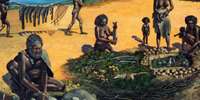 Fifty thousand years ago, a lush landscape greeted the first Australians making their way towards the south-east of the continent. Temperatures were cooler than now. Megafauna - giant prehistoric animals such as marsupial lions, goannas and the rhinoceros-sized diprotodon - were abundant. And the freshwater lakes of the Willandra district in western NSW were brimming with fish. But change was coming. By the time the people living at Lake Mungo ceremoniously buried two of their dead, 40 000 years ago, water levels had begun to drop.
Fifty thousand years ago, a lush landscape greeted the first Australians making their way towards the south-east of the continent. Temperatures were cooler than now. Megafauna - giant prehistoric animals such as marsupial lions, goannas and the rhinoceros-sized diprotodon - were abundant. And the freshwater lakes of the Willandra district in western NSW were brimming with fish. But change was coming. By the time the people living at Lake Mungo ceremoniously buried two of their dead, 40 000 years ago, water levels had begun to drop.
The age of Mungo Man is still in dispute - he may be as much as 60 000 years old.
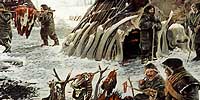 Dolni Vestonice is a classic example of Eastern Gravettian culture. This Paleolithic site was inhabited from ca. 27 000 to 23 000 B.C. The settlement had perhaps 100 people who inhabited the site the year round. In this period, Europe was in the midst of the Ice Age so the average daily temperature was probably around freezing, and the particular site was very close to the edge of the northern ice sheet. The site was on the edge of a swamp, and was at a point where mammoths and other herd animals could be funnelled in to make hunting them more easy.
Dolni Vestonice is a classic example of Eastern Gravettian culture. This Paleolithic site was inhabited from ca. 27 000 to 23 000 B.C. The settlement had perhaps 100 people who inhabited the site the year round. In this period, Europe was in the midst of the Ice Age so the average daily temperature was probably around freezing, and the particular site was very close to the edge of the northern ice sheet. The site was on the edge of a swamp, and was at a point where mammoths and other herd animals could be funnelled in to make hunting them more easy.
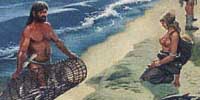
Lepenski Vir, a mesolithic settlement on the Danube in the Iron Gates region. Note the fish trap, baskets of fish, the trapezoidal house under construction, the stone hearth, the aurochs and deer, the water birds which have been caught, the spears and bow and arrow, the dog/wolf, the making of a sculpture, the clothes and the ceramic pot.
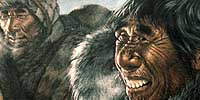
This delightful painting shows the Neanderthals as they were, successful and happy denizens of europe during the ice ages.
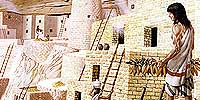
From approximately A.D. 600 through A.D. 1300 people lived and flourished in communities throughout the Mesa Verde area, eventually building elaborate stone villages in the sheltered alcoves of the canyon walls. The cliff dwellings represent the last 75 to 100 years of occupation at Mesa Verde. In the late 1200s within the span of one or two generations, they left their homes and moved away.
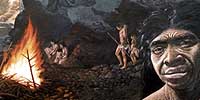 Homo erectus
Homo erectus
Choukoutien - Peking Man
Peking Man is the name given to an extinct hominid of the species homo erectus. The Peking Man fossils were discovered in the "Dragon Bone Hill" caves about 30 miles southwest of Beijing. They were first excavated by a Canadian, Davidson Black.
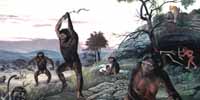 Australopithecus robustus
Australopithecus robustus
text below from:
http://www.wsu.edu:8001/vwsu/gened/learn-modules/ top_longfor/timeline/robustus/robustus-a.html
In the 1930's and 40's, the first specimens of robust australopithicines were discovered in east and southern Africa. These discoveries and the ones that have followed have considerably complicated our view of the hominid family tree. These creatures, which are now classified into several distinct species, represent a line - or several lines - of hominids which evolved alongside early human species and undoubtedly interacted with them.
And just for fun.......
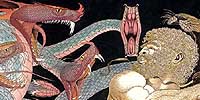 The Second Labour of Hercules : Destroying the Lernaean Hydra
The Second Labour of Hercules : Destroying the Lernaean Hydra
Killing the Hydra was easier said than done, since one of the heads was immortal and the others were almost as bad. As Hercules chopped off one, two new heads grew up to replace them. It was Iolaus who suggested burning the stumps before they had a chance to grow back. Hercules and Iolaus made a great team. The uncle chopped heads; the nephew burned the stumps before the new ones grew.
When all mortal heads had been chopped and burned, Hercules disposed of the one that was immortal by burying it securely under a gigantic rock. Hercules had accomplished his second labor. As a reward, he dipped his arrows in the monster's blood. Even a grazing shot from one of those arrows would kill.
text from:http://home.swipnet.se/~w-54567/hera/02.htm